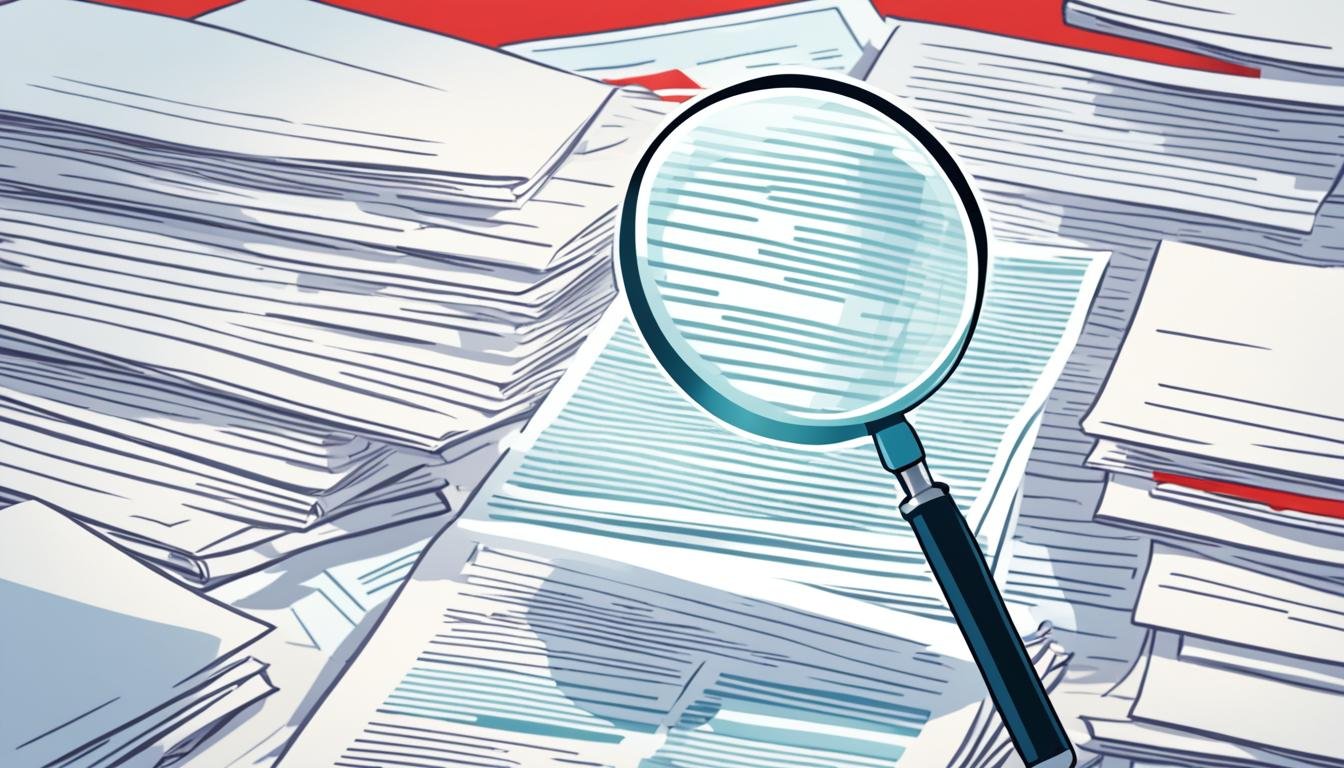Effective Compliance Auditing Techniques Explored
Did you know that organizations that prioritize compliance audits have 50% fewer instances of non-compliance? Compliance auditing is crucial for maintaining regulatory adherence and mitigating risks. By following best practices and adopting effective techniques, organizations can proactively identify and address non-compliance issues, ensuring a culture of integrity and minimizing the chances of facing penalties or reputational damage.
Key Takeaways:
- Regular compliance audits are essential for organizations to ensure regulatory adherence.
- Clear definition of scope and objectives, development of a detailed audit plan, and review of applicable laws and regulations are key steps in an effective compliance audit.
- Gathering and reviewing documentation, conducting interviews, assessing internal controls, and testing compliance activities are crucial components of a compliance audit.
- Communicating findings and recommendations, implementing corrective actions, and follow-up are necessary for continuous improvement and compliance.
- Organizations that prioritize compliance audits have 50% fewer instances of non-compliance.
Understand the Scope and Objectives
Before initiating a compliance audit, it is crucial to understand the scope and objectives of the audit. This involves identifying the relevant laws, regulations, and internal policies applicable to the organization and prioritizing areas that require immediate attention. By clearly defining the compliance audit objectives, organizations can align their audit activities to meet specific goals and outcomes.
Scope refers to the extent and boundaries of the compliance audit. It determines which areas of the organization, processes, functions, or departments will be assessed. By defining the compliance audit scope, organizations can ensure that all relevant areas are included in the audit, and no critical aspects are overlooked.
Key stakeholders should be involved in the initial stages of the compliance audit to gain a comprehensive understanding of the organization’s compliance requirements and challenges. This includes compliance officers, legal advisors, department heads, and other individuals who have a deep understanding of the organization’s operations and compliance landscape.
Engaging key stakeholders not only provides insights into the compliance requirements but also helps in identifying potential areas of non-compliance and risks. Their expertise and knowledge contribute to the overall effectiveness of the compliance audit. By involving key stakeholders from the beginning, organizations can ensure that the audit scope is well-defined and that the objectives are aligned with the organization’s goals.
In summary, understanding the scope and objectives of a compliance audit helps organizations prioritize their efforts, focus on key compliance requirements, and gain valuable insights from key stakeholders. This comprehensive understanding lays the foundation for a successful and effective compliance audit.
Develop a Detailed Audit Plan
Creating a detailed audit plan is crucial for a successful compliance audit. The audit plan serves as a roadmap, outlining the entire audit process, including timelines, roles, and responsibilities. It ensures that the audit is conducted efficiently, covering all necessary aspects.
Key elements to include in the audit plan:
- Audit Process: Clearly define the steps involved in the audit, from the initial planning phase to the final reporting and follow-up.
- Timelines: Set realistic deadlines for each stage of the audit to ensure a smooth and timely process.
- Roles and Responsibilities: Assign specific roles to team members involved in the audit, clearly defining their responsibilities and areas of focus.
- Compliance Requirements: Develop a checklist of compliance requirements to be assessed during the audit. This ensures comprehensive coverage of all relevant regulations and standards.
- Documentation Review: Specify the types of documentation to be reviewed, such as policies, procedures, contracts, and records. This helps evaluate the organization’s adherence to compliance-related documentation.
- Interviews: Outline the plan for conducting interviews with key stakeholders, employees, and managers. These interviews provide valuable insights into the overall compliance culture and help identify potential areas of non-compliance.
By developing a well-structured audit plan, organizations can ensure an organized and comprehensive approach to their compliance audits. This enables them to identify potential risks and areas of non-compliance, ultimately leading to enhanced regulatory adherence and continuous improvement.
Review Applicable Laws and Regulations
Thoroughly reviewing the relevant laws, regulations, and industry standards applicable to the organization is crucial for a comprehensive compliance audit. It is important to stay updated on any recent changes or amendments and cross-reference these requirements against internal policies and procedures to identify any gaps or discrepancies that need to be addressed.
An effective compliance assessment involves a thorough examination of the relevant legal framework within which the organization operates. This includes federal, state, and local laws, as well as industry-specific regulations. Compliance professionals must stay abreast of any updates or changes to ensure that the organization remains in full compliance at all times.
During the compliance audit, it is essential to identify and analyze any gaps between the organization’s internal policies and procedures and the pertinent regulations. This step helps uncover any deficiencies in compliance that may exist. By conducting this assessment, the organization can proactively address these gaps and enhance its compliance efforts.
One common challenge organizations face is the documentation gaps that may arise between their internal policies and regulatory requirements. These gaps can result from a lack of clarity or knowledge of existing laws and regulations, or from inadequate implementation of internal policies. Identifying and closing these gaps is crucial for organizations to ensure compliance and mitigate any potential legal or regulatory risks.
The compliance audit is an opportunity to assess the organization’s adherence to applicable laws and regulations, identify any gaps or discrepancies, and develop effective strategies to achieve and maintain compliance.
Effective compliance professionals utilize a systematic approach to reviewing laws and regulations during the audit process. This involves going beyond a surface-level understanding and conducting a detailed analysis of the legal requirements relevant to the organization’s industry and operations.
To ensure a comprehensive review, compliance professionals should:
- Identify the relevant laws and regulations: This includes federal, state, and local laws, industry-specific regulations, and any international laws that apply.
- Stay up-to-date with changes: Regularly monitor updates and amendments to laws and regulations to ensure full compliance.
- Review internal policies and procedures: Cross-reference internal policies and procedures with the applicable laws and regulations to identify any gaps or discrepancies.
- Document any gaps and discrepancies: Clearly document any identified gaps or discrepancies between internal policies and regulatory requirements.
By diligently reviewing applicable laws and regulations and addressing any gaps or discrepancies, organizations can enhance their compliance posture, minimize legal and regulatory risks, and ensure a strong foundation for achieving and maintaining compliance.
| Benefits of Reviewing Applicable Laws and Regulations | Actions |
|---|---|
| Identify compliance gaps | Thoroughly review and compare internal policies and procedures with relevant laws and regulations. |
| Mitigate legal and regulatory risks | Proactively address any gaps or discrepancies between internal policies and regulatory requirements. |
| Enhance compliance efforts | Ensure that the organization’s policies and procedures align with applicable laws and regulations. |
Gather and Review Documentation
Collecting and reviewing relevant documentation is a critical part of a compliance audit. Effective document management and record-keeping practices are essential to ensure compliance with retention periods and data privacy requirements. It is important to gather comprehensive and up-to-date documentation, including:
- Policies and procedures
- Contracts and agreements
- Licenses and permits
- Records and reports
Thoroughly reviewing these documents helps assess the organization’s adherence to applicable laws, regulations, and internal policies. It provides valuable insights into compliance practices and identifies any gaps or areas of non-compliance that need to be addressed.
During the document review process, it is crucial to ensure that the documentation is easily accessible and organized in a document management system. An efficient document management system facilitates easy retrieval, tracking, and version control of important documents. It streamlines the audit process and ensures that all necessary documents are readily available for review by auditors and other stakeholders.
The Benefits of Effective Document Management Systems
Effective document management systems simplify the compliance audit process and contribute to overall operational efficiency. They enable:
- Centralized storage and organization of documents
- Quick and easy access to relevant documentation
- Efficient tracking of document versions and revisions
- Seamless collaboration on document updates and reviews
By implementing a robust document management system, organizations can ensure that their record-keeping practices align with compliance requirements and improve their ability to provide accurate and timely documentation during audits.
Example Table: Document Management Best Practices
| Best Practice | Description |
|---|---|
| Document Classification | Implement a systematic approach to categorize and label documents based on their type, sensitivity, and importance. |
| Version Control | Establish a version control system that tracks and manages document revisions, ensuring that the latest version is always accessible. |
| Access Controls | Set up permissions and access controls to limit document access to authorized personnel, protecting sensitive information from unauthorized disclosure. |
| Regular Backups | Implement automated backups to ensure the integrity and availability of critical documents in case of system failures or data loss. |
| Retention Policy | Develop and enforce a document retention policy that aligns with legal and regulatory requirements, specifying the appropriate retention periods for different document types. |
Implementing these document management best practices enhances compliance and streamlines the audit process, allowing organizations to demonstrate accountability and transparency during compliance audits.
Conduct Interviews and Employee Awareness
Engaging in employee interviews across various departments and hierarchical levels is a critical component of a comprehensive compliance audit. These interviews provide valuable insights into compliance practices, employee awareness, and potential areas of concern. Moreover, they offer an opportunity to educate employees about their compliance obligations, address misconceptions, and reinforce the importance of compliance in day-to-day operations.
During the interviews, compliance officers and auditors can gain firsthand knowledge of the organization’s compliance practices. By directly interacting with employees, they can assess the level of awareness regarding regulatory requirements and internal policies. This enables proactive measures to address any gaps or misunderstandings, enhancing the overall compliance culture within the organization.
“Employee interviews provide a unique perspective on compliance practices and employee awareness. These conversations allow us to understand how well our compliance obligations are communicated and if any misconceptions exist. It is crucial to address any compliance-related misconceptions early on to foster a culture of compliance and minimize potential risks.”
– Sarah Thompson, Compliance Manager at ABC Corporation
During the interviews, it is important to create a comfortable environment that encourages open and honest communication. Employees should be assured that their responses will be confidential, fostering a safe space for sharing any concerns or observations regarding compliance practices. Compliance officers and auditors can ask targeted questions to gather valuable information about specific compliance areas, identify potential weaknesses, and obtain suggestions for improvement.
These employee interviews can be conducted through one-on-one conversations, focus group discussions, or survey questionnaires, depending on the size and structure of the organization. The selected method should ensure a comprehensive and representative sample of employees.
Enhancing Employee Awareness and Training Programs
Employee interviews not only serve as an assessment tool but also provide an opportunity to reinforce compliance awareness and knowledge. Through these conversations, compliance officers and auditors can identify the need for additional training or updates to existing programs.
Based on the insights gained from the interviews, organizations can develop targeted training initiatives that address the specific compliance areas where employees may exhibit knowledge gaps or misconceptions. These programs should be designed to educate employees on their compliance obligations, familiarize them with relevant laws and regulations, and provide practical guidance on how compliance practices should be integrated into their daily work routines.
Organizations can leverage various training methods, such as e-learning modules, workshops, and seminars, to deliver engaging and effective compliance training programs. By ensuring employees are well-informed about compliance expectations, organizations can minimize the risk of non-compliance and strengthen their overall compliance posture.
In conclusion, conducting employee interviews as part of a compliance audit is essential for organizations to gain insights into compliance practices, address misconceptions, and enhance overall employee awareness. These interviews provide a platform to educate employees about their compliance obligations, identify potential areas of improvement, and foster a culture of compliance within the organization. By proactively engaging with employees and developing targeted training initiatives, organizations can strengthen their compliance practices, minimize risks, and optimize their overall compliance strategy.
Assess Internal Controls and Processes
When conducting a compliance audit, it is essential to assess the effectiveness of internal controls and processes. By evaluating the organization’s control environment, you can identify potential compliance risks, control weaknesses, and vulnerabilities that may expose the organization to non-compliance.
Evaluating internal controls involves assessing various aspects, including segregation of duties, access controls, approval mechanisms, and monitoring systems. These controls play a crucial role in ensuring that compliance requirements are met and minimizing the likelihood of non-compliance.
Segregation of duties ensures that no single individual has complete control over a process or transaction, reducing the risk of fraud and errors. Assessing access controls involves reviewing the granting and revoking of system and data access privileges, ensuring that only authorized individuals can perform specific actions or access sensitive information.
Approval mechanisms refer to the formal processes in place for authorizing transactions, changes, or other activities. These mechanisms ensure that all actions are duly authorized, documented, and in compliance with established policies and procedures. Evaluating approval mechanisms helps identify any deviations from compliance requirements.
Monitoring systems, such as automated tools or manual processes, are crucial to detect and prevent compliance breaches. These systems provide ongoing surveillance of key controls and processes, allowing organizations to uncover potential non-compliance issues and take prompt corrective actions.
An effective assessment of internal controls and processes enables organizations to identify control weaknesses and vulnerabilities, allowing them to develop recommendations to strengthen controls and minimize compliance risks. Through a proactive approach, organizations can enhance their compliance efforts and reduce the likelihood of non-compliance incidents.
“Assessing internal controls is like shining a light on the organization’s compliance landscape. It reveals both the areas of strength and the vulnerabilities that need to be addressed.”
To provide a clear understanding of the assessment process, the following table illustrates the key elements that should be evaluated:
| Element | Description |
|---|---|
| Segregation of Duties | Review of the separation of responsibilities to prevent conflicts of interest and unauthorized actions. |
| Access Controls | Evaluation of the control measures to ensure proper access restrictions and user permissions. |
| Approval Mechanisms | Assessment of the formal processes in place for authorizing transactions and changes to prevent unauthorized activities. |
| Monitoring Systems | Review of the tools and processes for ongoing surveillance to detect compliance breaches and trigger timely corrective actions. |
Evaluating internal controls and processes is a critical step in ensuring compliance and minimizing risks. By identifying control weaknesses and vulnerabilities, organizations can take proactive measures to strengthen their controls, enhance compliance efforts, and maintain regulatory adherence.
Test Compliance Activities
Testing compliance activities is a crucial step in a comprehensive compliance audit. By selecting a sample of transactions, processes, or activities, organizations can evaluate their adherence to specific requirements. This testing process allows for the identification of potential non-compliance instances and helps in the development of corrective action plans.
During compliance testing, auditors may review various aspects of the organization, such as financial records, data privacy practices, employee contracts, or environmental compliance measures. By examining these specific areas, auditors can assess whether the organization is meeting the necessary compliance standards.
Standardized procedures are employed during compliance testing to ensure consistency and objectivity. These procedures serve as a framework for evaluating compliance and provide benchmarks for measuring performance across different areas of the organization. By using standardized procedures, auditors can effectively compare results and identify areas that require corrective action.
When conducting compliance testing, it is important to document findings, including instances of non-compliance. This documentation serves as evidence for the organization and helps in identifying patterns or recurring issues. By maintaining a record of findings, organizations can track progress, monitor improvements, and demonstrate their commitment to compliance.
To address instances of non-compliance identified during testing, corrective action plans are developed. These plans outline the necessary steps to rectify non-compliance issues and prevent their recurrence. By implementing corrective actions, organizations can mitigate risks, improve compliance performance, and ensure the organization aligns with industry standards and regulations.
Communicate Findings and Recommendations
Once the compliance audit is completed, it is imperative to prepare a comprehensive audit report that effectively communicates the findings and observations discovered during the audit process. This report serves as a crucial tool for documenting areas of non-compliance, identifying root causes, and providing recommendations for corrective actions that need to be implemented.
The audit report should be structured in a clear and concise manner, ensuring that relevant stakeholders and management can easily understand and act upon its contents. It should highlight the specific areas of non-compliance that were identified, including the associated risks and consequences. By clearly outlining the findings and observations, organizations can gain a comprehensive understanding of their compliance status and take appropriate measures to rectify any deficiencies.
Additionally, the audit report should provide practical recommendations for corrective actions to address the identified areas of non-compliance. These recommendations should be accompanied by specific timelines and assignments of responsibility to ensure accountability for implementation. By outlining actionable steps, organizations can effectively address non-compliance issues and minimize future risks.
It is essential to make the audit report easily accessible to relevant stakeholders and management for review and action. By ensuring its accessibility, the report can serve as a valuable reference document for decision-making and ongoing compliance efforts. The report also serves as a crucial tool for promoting transparency and accountability within the organization.
In conclusion, the preparation of a comprehensive audit report that clearly communicates the findings and observations and provides recommendations for corrective actions is a vital component of the compliance audit process. Through effective communication, organizations can gain valuable insights, address areas of non-compliance, and strengthen their overall compliance posture.
Implement Corrective Actions and Follow-Up
Monitoring the implementation of corrective actions and following up on their effectiveness is crucial in addressing identified non-compliance issues. Organizations must establish a system for tracking and documenting remediation efforts to ensure the timely resolution of compliance gaps. By regularly reviewing progress and providing necessary support, organizations can demonstrate a commitment to continuous improvement and compliance.
Implementing corrective actions involves taking prompt steps to address the non-compliance issues that have been identified during the compliance audit. These actions could include revising policies and procedures, providing additional training and education to employees, implementing new control measures, or strengthening existing controls.
Monitoring the implementation of corrective actions is essential to ensure that the necessary changes are effectively integrated into the organization’s operations. This involves closely tracking progress, conducting regular assessments, and verifying that the actions taken have resolved the compliance gaps and minimized the risk of future non-compliance.
Following up on the effectiveness of corrective actions is an ongoing process that requires continuous evaluation and improvement. Organizations should regularly assess the impact of the implemented actions, identify any potential gaps or shortcomings, and make necessary adjustments to optimize compliance performance.
In order to facilitate effective monitoring and follow-up, organizations can utilize various tools and techniques. These may include:
- Implementing a compliance monitoring system to track the progress of corrective actions and ensure accountability.
- Establishing clear responsibilities and timelines for the completion of corrective actions.
- Regularly reviewing and documenting the status of each corrective action to provide visibility and transparency.
- Conducting periodic audits or assessments to assess the overall effectiveness of implemented corrective actions.
- Engaging with key stakeholders and decision-makers to ensure ongoing support and commitment to compliance improvement.
By diligently monitoring the implementation of corrective actions and following up on their effectiveness, organizations can effectively address non-compliance issues, resolve compliance gaps, and strive for continuous improvement in their compliance practices.
Conclusion
Regular compliance audits using effective techniques are crucial for organizations to ensure regulatory adherence and optimize their audit strategy. By following a systematic approach that includes understanding the scope and objectives, developing a detailed audit plan, reviewing applicable laws and regulations, gathering and reviewing documentation, conducting interviews, assessing internal controls and processes, testing compliance activities, communicating findings and recommendations, implementing corrective actions, and conducting follow-up, organizations can effectively identify risks, detect non-compliance issues, and ensure timely corrective measures.
Continuous improvement plays a vital role in maintaining compliance and enhancing overall operational efficiency. Through a commitment to ongoing evaluation and enhancement of their compliance practices, organizations can stay proactive in identifying and addressing potential compliance gaps, keeping up with evolving regulations, and mitigating compliance risks. It is important to regularly reassess and fine-tune compliance auditing techniques to adapt to changing business landscapes and stay ahead of potential compliance challenges.
In conclusion, compliance auditing techniques enable organizations to proactively manage regulatory compliance by identifying potential issues, implementing corrective actions, and ensuring continuous improvement. By optimizing their audit strategy, organizations can effectively navigate the complex regulatory landscape, foster a culture of compliance, and safeguard their reputation and business interests.








